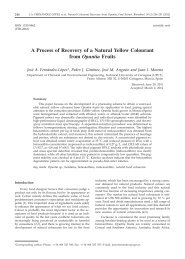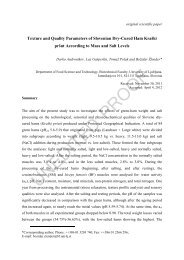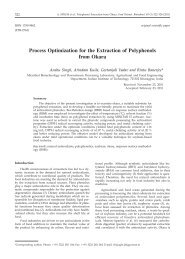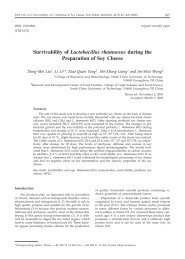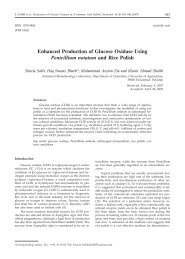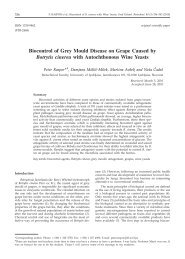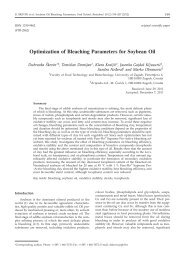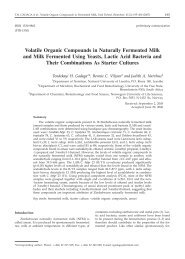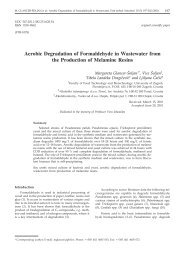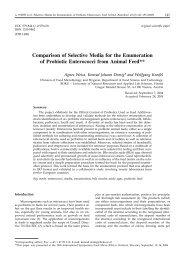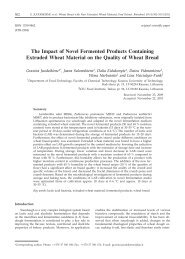Effect of Casein Hydrolysates on Yogurt Fermentation - Food ...
Effect of Casein Hydrolysates on Yogurt Fermentation - Food ...
Effect of Casein Hydrolysates on Yogurt Fermentation - Food ...
Create successful ePaper yourself
Turn your PDF publications into a flip-book with our unique Google optimized e-Paper software.
430 Q.Z. ZHAO et al.: <str<strong>on</strong>g>Effect</str<strong>on</strong>g> <str<strong>on</strong>g>of</str<strong>on</strong>g> <str<strong>on</strong>g>Casein</str<strong>on</strong>g> <str<strong>on</strong>g>Hydrolysates</str<strong>on</strong>g> <strong>on</strong> <strong>Yogurt</strong> Fermentati<strong>on</strong>, <strong>Food</strong> Technol. Biotechnol. 44 (3) 429–434 (2006)able to increase the survival <str<strong>on</strong>g>of</str<strong>on</strong>g> these bacteria in the yogurtproducts. The substances such as oligosaccharides(12), sugar sources (13) and n<strong>on</strong>-protein nitrogen (13,14)can improve the growth <str<strong>on</strong>g>of</str<strong>on</strong>g> probiotic bacteria. Vitamins,dextrin and maltose stimulate the growth <str<strong>on</strong>g>of</str<strong>on</strong>g> bifidobacteriaspecies in milk, while sucrose and ir<strong>on</strong> salts havelittle effect. Ascorbic acid, an oxygen scavenger (7), doesnot improve viability <str<strong>on</strong>g>of</str<strong>on</strong>g> bifidobacteria in yogurt, but itcan be applied to ensure better survival <str<strong>on</strong>g>of</str<strong>on</strong>g> L. acidophilusand B. bifidum in yogurt (15).Some protein hydrolysates enhance the acidificati<strong>on</strong>rate <str<strong>on</strong>g>of</str<strong>on</strong>g> yogurt and reduce the fermentati<strong>on</strong> time (8,16).However, these hydrolysates affect the texture and thephysical properties <str<strong>on</strong>g>of</str<strong>on</strong>g> the yogurt by changing the fermentati<strong>on</strong>time, starter culture metabolism, and interactingwith milk proteins to form the building blocks <str<strong>on</strong>g>of</str<strong>on</strong>g> thegel network. Supplementati<strong>on</strong> <str<strong>on</strong>g>of</str<strong>on</strong>g> milk with a combinati<strong>on</strong><str<strong>on</strong>g>of</str<strong>on</strong>g> casit<strong>on</strong>e, casein hydrolysate and fructose stimulatesthe growth <str<strong>on</strong>g>of</str<strong>on</strong>g> L. acidophilus (8). The probiotic in theyogurt with cysteine is less firm and less viscous thanyogurt without cysteine (17). Milk supplementati<strong>on</strong> withpeptides and amino acids may also increase the viability<str<strong>on</strong>g>of</str<strong>on</strong>g> probiotic organisms (14,18). Milk protein hydrolysatereduces fermentati<strong>on</strong> time and increases the viability <str<strong>on</strong>g>of</str<strong>on</strong>g>two strains <str<strong>on</strong>g>of</str<strong>on</strong>g> probiotic bacteria in milk (19). The yogurtswith casein and whey protein hydrolysates decreasethe complex viscosity and fermentati<strong>on</strong> time, and have amore open and less branched structure (20).In the present study, the effects <str<strong>on</strong>g>of</str<strong>on</strong>g> casein hydrolysateswith three different degrees <str<strong>on</strong>g>of</str<strong>on</strong>g> hydrolysis (DH=8.5,14.6 and 26.7 %) by papain <strong>on</strong> acidificati<strong>on</strong> and probioticcounts in yogurt have been investigated. The viability<str<strong>on</strong>g>of</str<strong>on</strong>g> probiotic bacteria and texture characteristics <str<strong>on</strong>g>of</str<strong>on</strong>g> yogurtsc<strong>on</strong>taining probiotic bacteria, and supplementedwith casein hydrolysates during storage at 4 °C havebeen evaluated.Materials and MethodsStrains and ingredientsThe commercial bacterial strain YC-370 (Streptococcusthermophilus and Lactobacillus delbrueckii ssp. bulgaricus)was used (Chr. Hansen, Guangzhou, China). Thestrain was stored at -40 °C in a c<strong>on</strong>centrate form andthen it was thawed and diluted 10 times in sterilizedskim milk just before inoculati<strong>on</strong>. The food grade enzyme(papain) was provided by Guangzhou EnzymeCo. (Guangzhou, China). Sodium casein was also purchasedfrom Chr. Hansen, Guangzhou, China.<str<strong>on</strong>g>Casein</str<strong>on</strong>g> hydrolysate preparati<strong>on</strong>A fracti<strong>on</strong> <str<strong>on</strong>g>of</str<strong>on</strong>g> 10 % <str<strong>on</strong>g>of</str<strong>on</strong>g> aqueous dispersi<strong>on</strong> <str<strong>on</strong>g>of</str<strong>on</strong>g> sodiumcasein was applied to enzymatic hydrolysis. The enzymatichydrolysis was carried out at 60 °C, c<strong>on</strong>stant pH=6.8with an enzyme to substrate ratio [E/S] <str<strong>on</strong>g>of</str<strong>on</strong>g> 380 U/g. Theenzyme was inactivated by heat treatment at 90 °C for10 min. The resulting mixture was rapidly cooled to ambienttemperature in the ice-water bath and then centrifuged(4000 rpm) for 20 min. The resulting supernatant(hydrolysate) was freeze-dried and then stored for furtherapplicati<strong>on</strong>. The hydrolysates with DH <str<strong>on</strong>g>of</str<strong>on</strong>g> 8.5, 14.6and 26.7 % were used as supplements to yogurt. Thesehydrolysates are expressed as CH1, CH2 and CH3.<strong>Yogurt</strong> preparati<strong>on</strong>Whole powdered milk, sucrose and the hydrolysateswere blended (model JB200-D, Japan). The protein c<strong>on</strong>tentwas standardized to w=5 % by the additi<strong>on</strong> <str<strong>on</strong>g>of</str<strong>on</strong>g> powderedskim milk (Chr. Hansen, Guangzhou, China). Thestandardized milk was supplemented with CH1, CH2and CH3 each at 0, 0.5, 1.0, 1.5 and 2.0 %. After beinghomogenized for 10 min at 20 MPa, it was heated (95°C, 5 min), cooled to 4 °C in an ice-water bath, pouredinto 250-mL flasks and stored for 24 h before testing.Standardized milk that was not supplemented with hydrolysateswas used as the c<strong>on</strong>trol (CK). Standardizedmilk samples were inoculated at the fermentati<strong>on</strong> temperature(42 °C) with 6.31·10 5 CFU/mL <str<strong>on</strong>g>of</str<strong>on</strong>g> bacterial strainYC 370 at inoculati<strong>on</strong> rates <str<strong>on</strong>g>of</str<strong>on</strong>g> 0.005 % (m/V), accordingto the manufacturer’s recommendati<strong>on</strong>. Inoculated milksamples were incubated at 42 °C until pH=4.40. Fermentati<strong>on</strong>was stopped by rapidly cooling the fermentedmilk to 4 °C in an ice-water bath. The cooled yogurt waspoured into 100-mL cups and stored at 4 °C.Chemical analysisC<strong>on</strong>tents <str<strong>on</strong>g>of</str<strong>on</strong>g> total nitrogen and n<strong>on</strong>-protein nitrogenwere measured by the Kjeldhal method (21). A c<strong>on</strong>versi<strong>on</strong>factor <str<strong>on</strong>g>of</str<strong>on</strong>g> 6.2 was used. All measurements were performedin duplicate.Molecular mass distributi<strong>on</strong> <str<strong>on</strong>g>of</str<strong>on</strong>g> the hydrolysatesThe molecular mass distributi<strong>on</strong> <str<strong>on</strong>g>of</str<strong>on</strong>g> the hydrolysateswas determined by Amersham Protein Analytical andPurifying System equipped with Superdex-peptide-10/300-Gl glass column. Eluting soluti<strong>on</strong> was phosphatebuffer 0.25 M (pH=7.2) and flow rate was 0.5 mL/min.Globin III (M r =2512), Globin II (M r =6214), Globin I (M r =8519), Globin I+III (M r =10700), Globin (M r =16949) wereused as standard peptides (Amersham).Acidificati<strong>on</strong>The pH <str<strong>on</strong>g>of</str<strong>on</strong>g> the fermented milk was m<strong>on</strong>itored at17–20 °C by using the Cinac pH meter after calibratingit with fresh pH=4.0 and 7.0 standard buffers. The timetaken for the pH to reach 4.4 was calculated as the fermentati<strong>on</strong>time. Coagulati<strong>on</strong> time expressed as the pHrecorded after 35-day storage period at 4 °C and post--fermentati<strong>on</strong> acidificati<strong>on</strong> were also recorded. This assaywas performed in four replicates <str<strong>on</strong>g>of</str<strong>on</strong>g> each sample.Probiotic countsProbiotic cell numbers during fermentati<strong>on</strong> and afterstorage for 30 days at 4 °C were recorded. Appropristerilewater and subsequently plated in duplicate <strong>on</strong> se-ate diluti<strong>on</strong>s <str<strong>on</strong>g>of</str<strong>on</strong>g> the samples were prepared in 0.1 % (m/V)lective media. Populati<strong>on</strong>s <str<strong>on</strong>g>of</str<strong>on</strong>g> Lactobacillus delbrueckii ssp.bulgaricus were enumerated <strong>on</strong> MRS agar plates at pH==5.4 and incubated at 37 °C for 72 h. Populati<strong>on</strong>s <str<strong>on</strong>g>of</str<strong>on</strong>g> S.thermophilus were enumerated <strong>on</strong> Elliker agar plates aftera 72-hour incubati<strong>on</strong> period at 37 °C.



